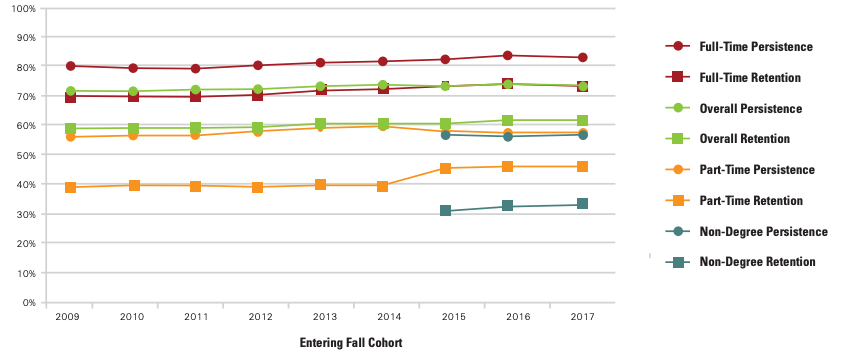- BLOG HOME
- »
- Research Services
- »
- 5 Practices for Improving Higher Education Retention Rates

5 Practices for Improving Higher Education Retention Rates
Earlier this month, the Research Center released the 2020 Persistence and Retention Report. Among the 2.6 million people who enrolled in college as a first-time undergraduate student in fall 2018, 67 percent (more than 1.7 million people) were retained at their starting institution.
What can four-year and two-year institutions do to improve their retention rates? Review these five practical strategies for retention and postsecondary success.
1. Collect Retention Data
Middle Tennessee State University created a Student Success Group to regularly identify, measure, and track key performance metrics. The school then distributed this data to all members of the leadership team, so they knew how their area was performing.
2. Implement an Academic Success Program
At Albion College, a private four-year liberal arts college in Michigan, they established an Academic Success Program (ASP). The program supports high-risk students by directly addressing issues related to academic underperformance. It includes:
- A two-credit course helps students understand success and failure;
- Three, two-hour study sessions a week to promote learning and achievement; and
- Academic coaching provided by staff members with extensive experience working with students who have academic difficulties.
As a result, one-semester retention rates for students on terminal probation went from 38.2 percent for non-ASP students to 71.6 percent for ASP students.
3. Develop Milestones
According to Hanover Research, milestones are one of the best ways to encourage students to graduate. Milestones are step-by-step academic goals that help students monitor their progress and understand what they are working toward. Setting measurable milestones is 80 percent effective in increasing retention and helping at-risk students.
Examples of measurable goals/milestones that can be set and monitored:
- Earn one-year of college-level credits
- Complete general education coursework
- Transfer from community college to a four-year institution
- Complete needed remediation
4. Create Retention Plans for All Levels
Each year, roughly two million students enter postsecondary education, however, eight years later, one-third of those individuals are no longer enrolled and have not earned any formal credentials, according to the National Student Clearinghouse Research Center’s Some College, No Degree report. Because of this, it is essential to create retention strategies for every step of a student’s journey.
5. Offer Online Courses
Online courses are associated with increased retention and graduation rates. They offer financially struggling students cost savings. According to a study by Arizona State University, offering digital courses improves student learning outcomes by helping students earn their degree faster and return to the workforce sooner. In addition, online classes offer improved access to education for disadvantaged students. The key is taking a strategic approach to digital learning by tailoring an online portfolio to the particular needs of your student population.
To learn more about retention rates and need research assistance, contact the Research Center.
First-Year Persistence and Retention by Starting Enrollment Intensity, All Institutions, 2009-2017

Each year, roughly two million students enter postsecondary education, however, eight years later, one-third of those individuals are no longer enrolled and have not earned any formal credentials, according to the National Student Clearinghouse Research Center’s Some College, No Degree report.
Additional Resources:



